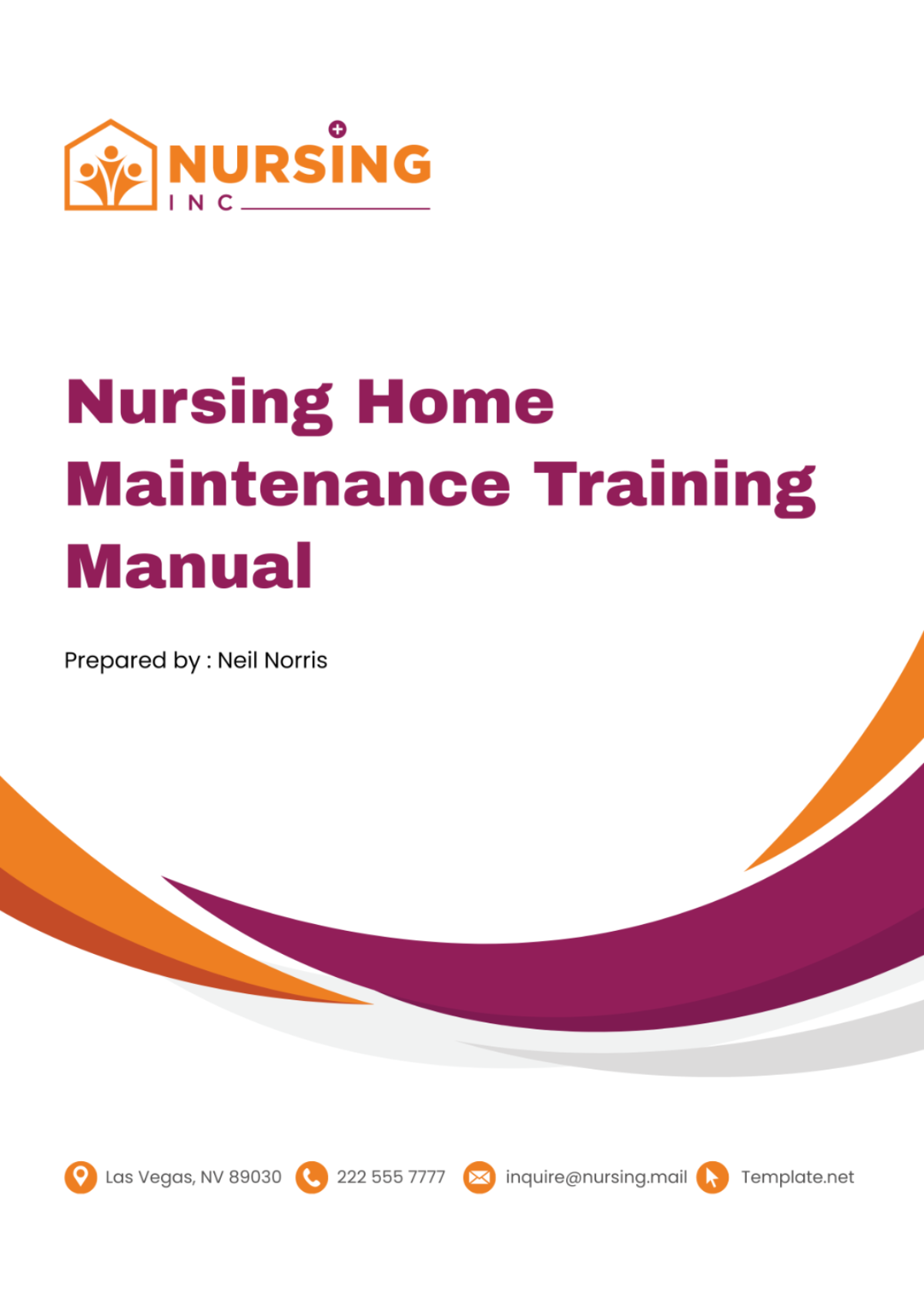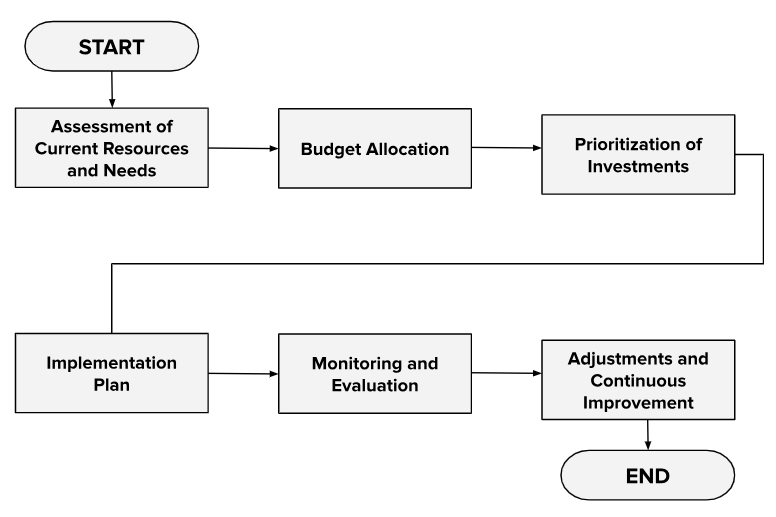Free Nursing Home Maintenance Training Manual

A. Introduction and Overview
Welcome to [Your Company Name] Training Manual. In this comprehensive guide, we aim to familiarize our maintenance staff with vital aspects of their job responsibilities. This manual serves to provide a routine structure and safety protocol adherence for every individual involved.
The role of maintenance staff extends beyond routine tasks. Their services ensure a safe, clean, and comfortable environment conducive to the well-being of our residents. This manual will guide you through the essential functions and practices of maintenance in a nursing home environment.
B. Safety Procedures and Protocols
Ensuring the safety of our residents, staff, and facilities is paramount at [Your Company Name]. This section outlines essential safety procedures and protocols that all maintenance staff must follow diligently. By adhering to these protocols, we not only meet regulatory requirements but also cultivate a culture of safety where every team member is empowered to identify and address potential hazards promptly. Regular safety drills and updates will be integral to our ongoing commitment to safety excellence.
1. Chemical Handling and Storage
Properly label all chemicals and store them in designated areas.
Follow manufacturer's instructions for use and disposal of chemicals.
Wear appropriate personal protective equipment (PPE) when handling chemicals, including gloves, goggles, and aprons.
In case of spills or accidents, follow established cleanup procedures and promptly report incidents to management.
2. Personal Protective Equipment (PPE) Usage
Wear PPE as required for specific tasks, such as using gloves when handling waste or cleaning solutions.
Inspect PPE regularly for damage or wear and replace as needed.
Ensure proper fit and use of PPE to provide adequate protection against hazards.
Attend training sessions on the correct usage and maintenance of PPE.
3. Emergency Response Procedures
Familiarize yourself with emergency exits, evacuation routes, and assembly points.
Know how to respond to different types of emergencies, including fires, medical emergencies, and hazardous material spills.
Participate in regular emergency drills to practice response procedures.
Follow the chain of command and communicate effectively during emergencies to ensure a coordinated response.
4. Electrical Safety
Avoid overloading electrical outlets and circuits.
Inspect electrical cords and equipment for damage before use.
Use ground fault circuit interrupters (GFCIs) in wet or damp areas to prevent electrical shocks.
Report any electrical hazards or malfunctions to maintenance immediately.
5. Slip, Trip, and Fall Prevention
Keep floors clean and dry to prevent slips and falls.
Use caution signs to alert others of wet or slippery floors.
Repair or replace damaged flooring, tiles, or carpeting promptly.
Ensure adequate lighting in hallways, stairwells, and common areas to enhance visibility and reduce the risk of tripping hazards.
6. Tool and Equipment Safety
Inspect tools and equipment before use to ensure they are in good working condition.
Follow manufacturer's guidelines and safety instructions when operating machinery or power tools.
Use proper lifting techniques to prevent strains and injuries.
Store tools and equipment securely when not in use to prevent accidents or unauthorized access.
C. Facility Maintenance Basics
Maintaining the physical infrastructure of [Your Company Name] is essential to ensure a safe and comfortable environment for our residents. This section provides an overview of fundamental facility maintenance practices that all maintenance staff should be familiar with. By following these basic maintenance procedures, we can uphold the highest standards of quality and safety throughout our facility.
HVAC Maintenance |
|
Plumbing Repairs |
|
Electrical Safety Checks |
|
Building Inspections |
|
Groundskeeping |
|
General Repairs and Maintenance |
|
D. Equipment Maintenance and Repair
Proper maintenance and repair of equipment are critical to ensuring the smooth operation of [Your Company Name] and the safety of our residents and staff. This section outlines guidelines for the maintenance and repair of various equipment used in our facility. By following these procedures diligently, we can prolong the lifespan of our equipment and minimize the risk of malfunctions or breakdowns.
Medical Devices |
|
Kitchen Appliances |
|
Facility Vehicles |
|
Safety Equipment |
|
Office Equipment |
|
E. Infection Control Procedures
Infection control is paramount in maintaining the health and well-being of residents and staff at [Your Company Name]. This section focuses on infection control procedures, which encompass measures to prevent the spread of infections within our facility. From routine cleaning protocols to outbreak management strategies, these procedures are designed to mitigate the risk of infectious diseases and promote a safe environment for all.

Assessment of Current Resources and Needs
Evaluate existing resources and capabilities for infection control, including staff training, cleaning supplies, and personal protective equipment (PPE).
Identify any gaps or deficiencies in resources that may hinder effective infection control practices.
Budget Allocation
Determine the budget allocation for infection control initiatives based on identified needs and priorities.
Consider factors such as staffing requirements, procurement of PPE and cleaning supplies, and investment in training programs.
Prioritization of Investments
Prioritize investments in infection control measures based on the level of risk and potential impact on resident and staff safety.
Allocate resources to areas with the greatest need, such as high-traffic areas, resident rooms, and communal spaces.
Implementation Plan
Develop a comprehensive plan for implementing infection control measures, including timelines, responsibilities, and monitoring mechanisms.
Ensure that staff are adequately trained on new protocols and procedures to facilitate successful implementation.
Monitoring and Evaluation
Establish protocols for monitoring and evaluating the effectiveness of infection control initiatives.
Regularly review infection rates, compliance with protocols, and feedback from staff and residents to identify areas for improvement.
Adjustments and Continuous Improvement
Use data and feedback gathered from monitoring and evaluation processes to make adjustments to infection control strategies as needed.
Foster a culture of continuous improvement by encouraging staff participation in identifying and addressing infection control challenges.
F. Documentation and Record-Keeping
Accurate documentation and record-keeping are essential components of effective infection control and overall facility management at [Your Nursing Home]. This section emphasizes the importance of thorough documentation practices to track maintenance activities, infection control measures, and resident health data. By maintaining detailed records, we can ensure regulatory compliance, facilitate communication among staff members, and identify trends or patterns that may require attention.
Maintenance Logs
Keep detailed logs of all maintenance activities, including repairs, inspections, and preventive maintenance tasks.
Record dates, descriptions of work performed, and any associated expenses or materials used.
Infection Control Reports
Document all infection control measures implemented within the facility, including cleaning protocols, outbreak responses, and staff training sessions.
Maintain records of infection rates, outbreaks, and any actions taken to prevent or mitigate the spread of infectious diseases.
Resident Health Records
Maintain accurate and up-to-date health records for all residents, including medical histories, medication administration records, and treatment plans.
Document any changes in residents' health status, symptoms, or care needs, as well as communication with healthcare providers and family members.
raining Documentation
Keep records of staff training sessions, certifications, and competency assessments related to infection control, safety procedures, and resident care.
Document attendance, topics covered, and any assessments or evaluations conducted during training sessions.
Regulatory Compliance Records
Ensure compliance with regulatory requirements by maintaining records of inspections, audits, and corrective actions taken to address any deficiencies.
Keep copies of licenses, permits, and certifications required for operating the nursing home facility.
Communication Logs
Document all communication between staff members, residents, family members, and external healthcare providers regarding resident care, facility maintenance, and infection control measures.
Record important details, such as dates, times, individuals involved, and the nature of the communication.
G. Training and Development Opportunities
At [Your Company Name], we recognize the value of continuous learning and professional development for our staff. This section highlights various training and development opportunities available to enhance the skills and knowledge of our maintenance team. By investing in training and development, we empower our staff to excel in their roles and contribute to the overall success of our facility.
Below is a list of diverse training opportunities to enhance skills and knowledge, ensuring excellence in maintenance practices at [Your Company Name].
Occupational Safety and Health Administration (OSHA) Training
HVAC Maintenance Certification Programs
Plumbing Repair Workshops
Electrical Safety Training
Infection Control Seminars
Equipment Maintenance and Repair Courses
Emergency Response Drills
Continuing Education in Facility Management
Software Training for Maintenance Management Systems
Leadership Development Workshops
H. Feedback and Support
We always welcome feedback and questions from our team members. If you come across any issues or have suggestions to improve our work environment, feel free to reach us. For further assistance, you can contact us at [Your Company Number] or send an email to [Your Company Email].
- 100% Customizable, free editor
- Access 1 Million+ Templates, photo’s & graphics
- Download or share as a template
- Click and replace photos, graphics, text, backgrounds
- Resize, crop, AI write & more
- Access advanced editor
Empower your maintenance team with the Nursing Home Maintenance Training Manual Template from Template.net. This editable and customizable template covers essential skills, safety protocols, and best practices for maintaining a safe and functional nursing home environment. Editable in our Ai Editor Tool, it's vital for equipping staff with the knowledge to handle routine and emergency maintenance tasks effectively, ensuring the well-being and comfort of residents.





























